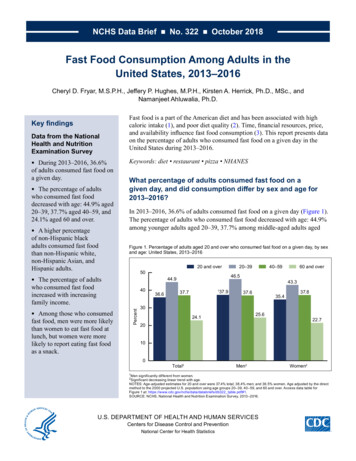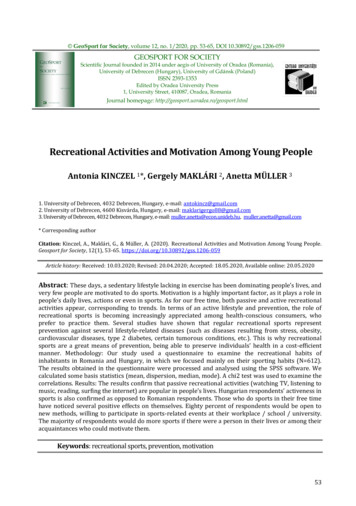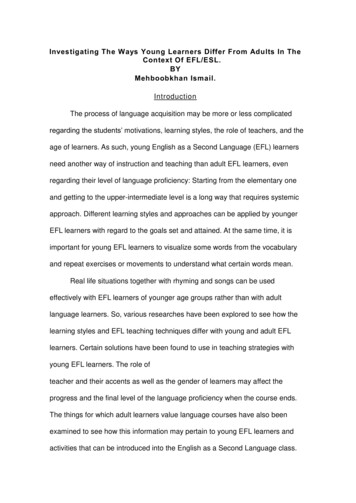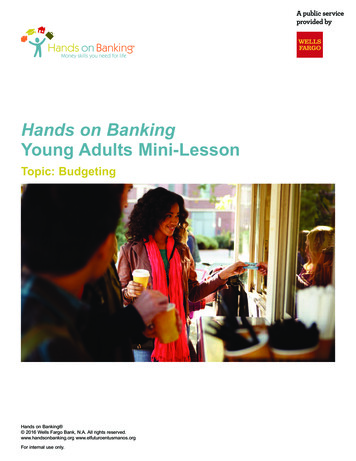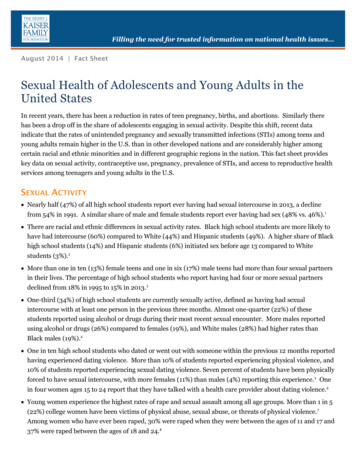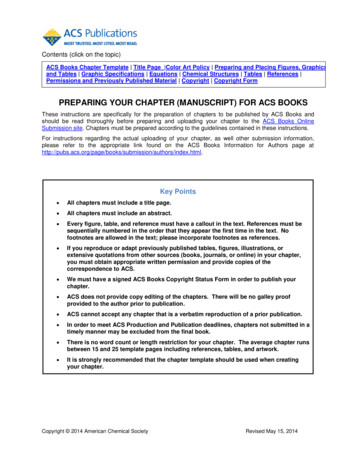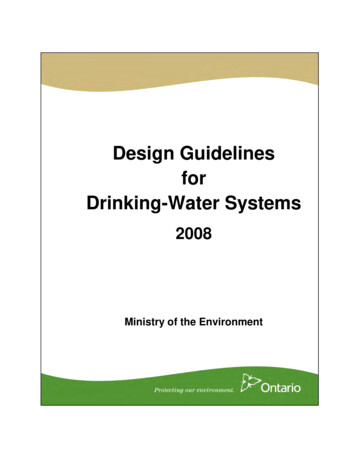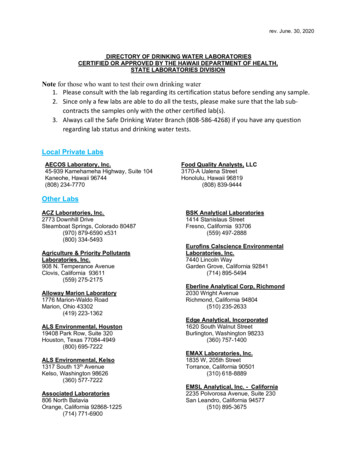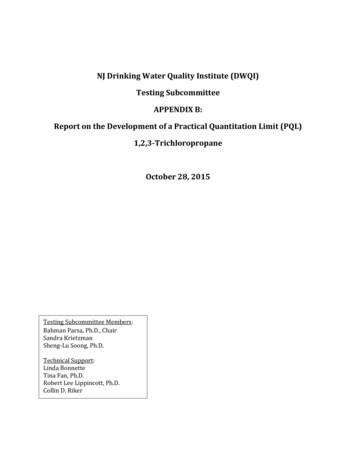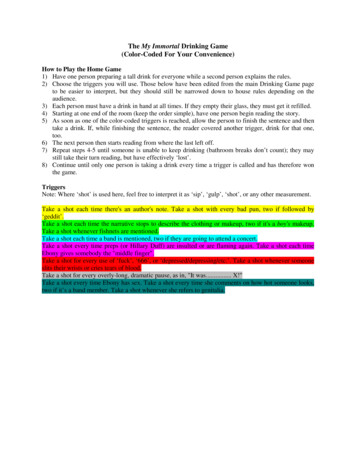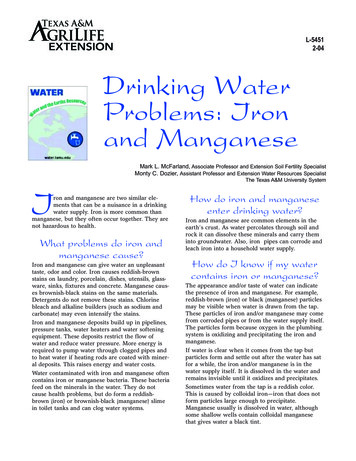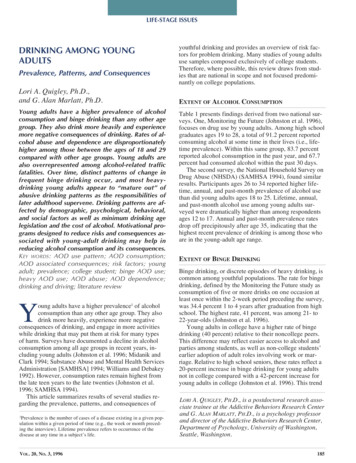
Transcription
LIFE STAGE ISSUESDRINKING AMONG YOUNGADULTSPrevalence, Patterns, and ConsequencesLori A. Quigley, Ph.D.,and G. Alan Marlatt, Ph.D.Young adults have a higher prevalence of alcoholconsumption and binge drinking than any other agegroup. They also drink more heavily and experiencemore negative consequences of drinking. Rates of al cohol abuse and dependence are disproportionatelyhigher among those between the ages of 18 and 29compared with other age groups. Young adults arealso overrepresented among alcohol related trafficfatalities. Over time, distinct patterns of change infrequent binge drinking occur, and most heavy drinking young adults appear to “mature out” ofabusive drinking patterns as the responsibilities oflater adulthood supervene. Drinking patterns are af fected by demographic, psychological, behavioral,and social factors as well as minimum drinking agelegislation and the cost of alcohol. Motivational pro grams designed to reduce risks and consequences as sociated with yo ung adult drinkin g may he lp inreducing alcohol consumption and its consequences.K EY WORDS: AOD use pattern; AOD consumption;AOD associated consequences; risk factors; youngadult; prevalence; college student; binge AOD use;heavy AOD use; AOD abuse; AOD dependence;drinking and driving; literature reviewYoung adults have a higher prevalence1 of alcoholconsumption than any other age group. They alsodrink more heavily, experience more negativeconsequences of drinking, and engage in more activitieswhile drinking that may put them at risk for many typesof harm. Surveys have documented a decline in alcoholconsumption among all age groups in recent years, in cluding young adults (Johnston et al. 1996; Midanik andClark 1994; Substance Abuse and Mental Health ServicesAdministration [SAMHSA] 1994; Williams and Debakey1992). However, consumption rates remain highest fromthe late teen years to the late twenties (Johnston et al.1996; SAMHSA 1994).This article summarizes results of several studies re garding the prevalence, patterns, and consequences of1Prevalence is the number of cases of a disease existing in a given pop ulation within a given period of time (e.g., the week or month preced ing the interview). Lifetime prevalence refers to occurrence of thedisease at any time in a subject’s life.VOL. 20, NO. 3, 1996youthful drinking and provides an overview of risk fac tors for problem drinking. Many studies of young adultsuse samples composed exclusively of college students.Therefore, where possible, this review draws from stud ies that are national in scope and not focused predomi nantly on college populations.EXTENT OF ALCOHOL CONSUMPTIONTable 1 presents findings derived from two national sur veys. One, Monitoring the Future (Johnston et al. 1996),focuses on drug use by young adults. Among high schoolgraduates ages 19 to 28, a total of 91.2 percent reportedconsuming alcohol at some time in their lives (i.e., life time prevalence). Within this same group, 83.7 percentreported alcohol consumption in the past year, and 67.7percent had consumed alcohol within the past 30 days.The second survey, the National Household Survey onDrug Abuse (NHSDA) (SAMHSA 1994), found similarresults. Participants ages 26 to 34 reported higher life time, annual, and past month prevalence of alcohol usethan did young adults ages 18 to 25. Lifetime, annual,and past month alcohol use among young adults sur veyed were dramatically higher than among respondentsages 12 to 17. Annual and past month prevalence ratesdrop off precipitously after age 35, indicating that thehighest recent prevalence of drinking is among those whoare in the young adult age range.EXTENT OF BINGE DRINKINGBinge drinking, or discrete episodes of heavy drinking, iscommon among youthful populations. The rate for bingedrinking, defined by the Monitoring the Future study asconsumption of five or more drinks on one occasion atleast once within the 2 week period preceding the survey,was 34.4 percent 1 to 4 years after graduation from highschool. The highest rate, 41 percent, was among 21 to22 year olds (Johnston et al. 1996).Young adults in college have a higher rate of bingedrinking (40 percent) relative to their noncollege peers.This difference may reflect easier access to alcohol andparties among students, as well as non college students’earlier adoption of adult roles involving work or mar riage. Relative to high school seniors, these rates reflect a20 percent increase in binge drinking for young adultsnot in college compared with a 42 percent increase foryoung adults in college (Johnston et al. 1996). This trendLORI A. QUIGLEY, PH.D., is a postdoctoral research asso ciate trainee at the Addictive Behaviors Research Centerand G. ALAN MARLATT, PH.D., is a psychology professorand director of the Addictive Behaviors Research Center,Department of Psychology, University of Washington,Seattle, Washington.185
LIFE STAGE ISSUESTable 1 Prevalence (%) of Alcohol Use and Heavy/Binge Drinking Among Young AdultsAlcohol Use (%)StudyAge GroupLifetimeAnnualPast30 DaysHeavy/BingeDrinking1Monitoring the Future219–2891.283.767.733.7National Household Surveyon Drug Abuse35 5.248.862.859.318.04.27.310.41.31Binge drinking was defined in the Monitoring the Future study as consumption of five or more drinks at least once during the 2 week period preceding the survey. Heavy drinkingin the National Household Survey on Drug Abuse was defined as consumption of five or more drinks on each of 5 or more days in the past 30 days.2Survey of high school graduates.SOURCE: Adapted from Johnston et al. 1996 and Substance Abuse and Mental Health Services Administration 1994.toward heavy drinking appears to begin before college,however. In fact, those who are among the heaviestdrinkers in high school are likely to continue drinkingheavily following graduation, whether or not they plan toenter college (Baer et al. 1995). Surprisingly, college bound high school seniors report binge drinking in highschool less frequently than non college bound students(Johnston et al. 1996).In the NHSDA, 18 to 25 year old respondentsshowed a lower prevalence of alcohol consumption thanthe 26 to 34 year old cohort. With regard to patternsof heavier consumption, however, the younger group re ported a higher prevalence of heavy drinking or frequentmonthly binge drinking. The rates of frequent monthlybinge drinking, defined as drinking five or more drinksper day on each of 5 or more days in the past 30 days, arepresented in table 1 (SAMHSA 1994). According to theNHSDA, heavy drinking increases during young adult hood and declines somewhat after the mid thirties.Gender differences are also apparent in binge drinkingrates (Johnston et al. 1996; SAMHSA 1994). Men be tween the ages of 19 and 32 were more likely to be bingedrinkers than were women, based on a binge drinkingcriterion of five or more drinks on one occasion in theprevious 2 weeks (Johnston et al. 1996). The five drinkcriterion, however, has been shown to underestimate theprevalence of binge drinking among women (Wechsleret al. 1995a). A four drink binge criterion for women hasbeen recommended by Wechsler to correct for genderdifferences in body mass and alcohol metabolism and toapproximate equal likelihood of drinking related conse quences between genders (Wechsler et al. 1995a). Theapplication of this criterion would result in a binge drinking rate of 39 percent among young adult collegewomen, which is considerably higher than the 33 percentrate that would result from the five drink criterion(Wechsler et al. 1995a).Ethnic and regional differences in frequent monthlybinge drinking rates also have been documented. WhiteNHSDA respondents most often reported frequent186monthly binge drinking, followed by Hispanic and African American respondents (SAMHSA 1994). A pattern offrequent binge drinking was reported less often by re spondents living in the southern region of the UnitedStates compared with those in the northeastern, northcentral, and western regions (SAMHSA 1994). Similarly,Wechsler and colleagues (1994) found that colleges inthe northeast and north central regions had higher rates ofbinge drinking than those in the South and West.CONSEQUENCES OF DRINKING AMONG YOUNG ADULTSAlcohol Abuse and Alcohol DependenceNot only do young adults have a higher prevalence ofalcohol consumption and binge drinking than other agegroups, they also are overrepresented in diagnosable ratesof alcohol related disorders (i.e., alcohol abuse and alco hol dependence). The criteria for these disorders reflect inpart the physical, occupational, interpersonal, and psy chological consequences associated with the use of al cohol. Criteria for diagnosing alcohol abuse and alcoholdependence are outlined in the Diagnostic and StatisticalManual of Mental Disorders, Fourth Edition (DSM–IV)(American Psychiatric Association [APA] 1994).Alcohol abuse generally refers to a maladaptive drink ing pattern involving recurrent difficulties in one or moreof the following areas: failure to fulfill major obligations(e.g., the demands of school, employment, or parenthood),alcohol use in physically hazardous situations (e.g., driving,boating, or skiing), legal difficulties caused by drinking(e.g., arrest for driving while intoxicated), and alcohol related social consequences (e.g., engaging in physicalfights) (APA 1994).Criteria for alcohol dependence include tolerance, with drawal,2 impaired control over alcohol use (e.g., difficultycutting down or drinking more than intended), narrowingof nondrinking activities (i.e., alcohol plays a pervasiveALCOHOL HEALTH & RESEARCH WORLD
LIFE STAGE ISSUESrole in many life activities), and continued use of alcoholdespite knowledge of associated adverse consequences(APA 1994). A diagnosis of alcohol dependence (i.e.,alcoholism) precludes the diagnosis of alcohol abuse.One year prevalence for alcohol abuse is the morecommon of the two alcohol related disorders (table 2)(Grant 1994). In total, just under 9 percent of the adult(i.e., age 18 and older) U.S. population meet 1 yearprevalence criteria (according to DSM–IV criteria) foreither alcohol abuse or dependence (Grant 1994). One year prevalence rates for alcohol abuse and dependenceamong adults in the United States are higher for men thanfor women. Rates of alcohol abuse and dependence aredisproportionately higher among people between the agesof 18 and 29 compared with other age groups. Almostone fourth of young men in the United States meet thecriteria for 1 year prevalence for an alcohol use disorder.Just over one half of these men meet the diagnostic crite ria only for alcohol abuse, and the remaining men meetthe criteria for alcohol dependence as well. Prevalencerates for alcohol use disorders are considerably lower forwomen in this age range. These rates are higher amongwhite men and women compared with their nonwhitepeers (Grant 1994), consistent with ethnic group differ ences in prevalence of consumption and binge drinking.Drinking and DrivingYoung adults are overrepresented among alcohol relatedtraffic fatalities (National Highway Traffic Safety Admin istration 1994). Although young adult drivers ages 16through 25 make up only 15 percent of U.S. licensed drivers,they constitute 28 percent of drinking driver fatalities(Campbell et al. 1995). Furthermore, youth between theages of 16 and 24 make up 30 percent of all alcohol related driving fatalities, including fatalities of drivers,passengers, and nonoccupants (Campbell et al. 1995).Inexperience with both driving and drinking may con tribute to this disproportionate rate.Young adult drivers (ages 16 to 24) involved in auto mobile accidents are more likely to have a lower bloodalcohol concentration (BAC) than older drivers (Campbellet al. 1995). This pattern may reflect greater impairmentand lower alcohol tolerance among less experienceddrinkers who drive after drinking.Other Alcohol Related ConsequencesMany studies of young adults’ alcohol consumptionpatterns have used samples of college students, limitingresearchers’ ability to generalize study findings to otheryoung adult populations. However, because the mostdetailed information about the nature and prevalence of2Tolerance indicates that increasing quantities of a drug are required toproduce a given effect. Withdrawal occurs upon discontinuation ofheavy drug use and may be characterized by anxiety, sweating, elevat ed blood pressure, hallucinations, and, in severe cases, seizures.VOL. 20, NO. 3, 1996Table 2 Prevalence (%) of Alcohol Use Disorders1 in theGeneral Population and Among Young Men andWomen Ages 18 to 29GeneralPopulationMenWomenAlcohol UseDisorder18 18 18–2918 811.012.094.98Total Alcohol Use Disorders8.5613.2723.714.31 13.831Criteria for alcohol abuse and dependence as outlined in the Diagnostic andStatistical Manual of Mental Disorders, Fourth Edition (American PsychiatricAssociation 1994).SOURCE: Adapted from Grant 1994.alcohol related consequences within this age group hasbeen gathered from college students, some examples ofthe more comprehensive studies are presented here.Hanson and Engs (1992) administered four surveysover a 10 year period to students from 4 year colleges inthe United States. In the most recent of these surveys,16.9 percent of the respondents who drank indicated thatwithin the past year, they had become involved in a fightafter consuming alcohol, and 10.3 percent indicated thatthey had engaged in ill advised behavior, such as damag ing property or sending false fire alarms, after drinking.The 1 year prevalence of each of these consequencesincreased significantly over four assessments from 1982to 1991 (Hanson and Engs 1992). Sociocultural and otherfactors may affect the generalizability of these findings totoday’s college students. The findings are useful, however,as an approximation of general trends in the nature andprevalence of alcohol related consequences that collegestudents experience.Wechsler and colleagues (1994, 1995a,b) conducted anational survey of college students to determine the ex tent of health related and behavioral consequences asso ciated with binge drinking. The minimum binge drinkingcriteria in this study were five drinks per occasion formen and four for women. Consequences reported moreoften by binge drinkers included arguments with friends,getting hurt or injured, and damaging property. The fre quency of such consequences was related to the frequencyof the subject’s binge drinking. Forty seven percent of thestudents who frequently engaged in binge drinking (threeto four binges in the past 2 weeks) reported five or morealcohol related consequences during the school year,compared with 14 percent of those who were less fre quent binge drinkers and 3 percent of drinkers who didnot binge within the past year. Among these consequenceswere personal injury, property damage, unplanned sexualactivity, and unprotected sex.187
LIFE STAGE ISSUESAlthough specific consequences of drinking have notbeen reported for noncollege young adult samples, it islikely that many of the same consequences would occurgiven comparable levels of consumption.BINGE DRINKING AND THE MATURATION PROCESSAlthough the pattern of drinking and the amount con sumed remain similar from late adolescence throughyoung adulthood, most heavy drinking young adultsappear to “mature out” of abusive drinking patterns asthey pass into subsequent stages of adulthood.Schulenberg and colleagues (1996) evaluated chang ing patterns of binge drinking among young adults whowere initially assessed during their senior year in highschool and who completed three subsequent biennialassessments. Frequent binge drinking was defined as twoor more five drink binge episodes in the past 2 weeks.Statistical analysis of the results confirmed the existenceof six distinct patterns of change3 in frequent binge drink ing over time. These differing patterns correspond toclassifications of problem drinking as well as to patternsof maturation. Frequent binge drinkers who maintainedtheir heavy drinking levels throughout the survey periodmade up 6.7 percent of this sample. The researchersconcluded that this group corresponded most closely tothe antisocial type of alcoholism described by Zucker(1994), in which problem drinking is only one of a con stellation of behavioral problems that begin in childhoodand continue through adulthood.Another group of respondents who were initially fre quent binge drinkers were no longer frequent bingedrinkers at the time of the final assessment (Schulenberget al. 1996). This pattern of decreasing frequency maycorrespond to what has been called the “developmentallylimited” type of problem drinking. This type resemblesantisocial drinking in most respects except for its limitedduration. Zucker (1994) relates this type of alcohol prob lem to normal adolescent development and the process ofindividuating from parents.Most young adults in the study who engaged in bingedrinking matured out of this pattern of drinking over time.Some of these respondents decreased their binge drinkinggradually, whereas others experienced a brief (“fling”)period of binge drinking between periods of no bingedrinking. Some young adults increased the frequency ofdrinking over time, perhaps responding to the increasedopportunities for drinking available to young adults; thesesubjects may or may not mature out of this pattern overtime. Understanding the changes in drinking patterns asthese individuals approach mid adulthood may clarify theprocesses involved in later onset binge drinking.Marital status, ethnicity, and number of years of edu cation may be predictive of continued binge drinking.3The pattern of “never binge drinking” will not be discussed here.188Those who had not married by age 23 or 24 were gener ally more likely to continue or increase episodes of bingedrinking. Caucasians tended to be the ethnic group mostlikely to maintain or increase binge drinking. Men whohad more years of education or whose parents had moreyears of education were more likely to continue or in crease their binge drinking frequency. Men who engagedin frequent reckless driving were less likely to mature outthan nonreckless drivers (Schulenberg et al. 1996), afinding that is consistent with the antisocial types ofalcohol problems. Women who had received financialsupport from their parents were more likely to increaserisky patterns of drinking than women receiving no sup port (Schulenberg et al. 1996).Changes in marital and employment status also havebeen associated with changes in consumption. Specifically,Temple and colleagues (1991) found an association be tween becoming married and decreases in typical quantityof consumption across age groups and for both men andwomen. Remaining or becoming single, on the other hand,was associated with increased consumption for men andwomen under age 40 (Temple et al. 1991).Regarding employment status, Temple and colleagues(1991) found a modest association between the initiationof employment and increased consumption for youngmen and women, possibly because of increased financialresources. This finding appears to be contrary to theorieswhich propose that increases in adult responsibilities,such as employment, would decrease consumption levels.It is unclear, however, whether changes in the pattern ofdrinking among newly employed young adults occur inresponse to employment (e.g., typical quantity may in crease, but weeknight frequency of consumption maydecrease). Becoming unemployed was associated withincreased typical quantity of consumption for men under40 but not for young women. Chronic or long term un employment was associated with decreases in consump tion for young adult women (under age 40) but wasassociated with an increase in typical quantity of con sumption for young men (Temple et al. 1991).RISK FACTORS FOR ALCOHOL RELATED PROBLEMSGiven that the highest prevalence of heavy drinking andassociated problems occurs during the late teens and earlyto mid twenties, young adulthood may be considered arisk period for heavy drinking and related consequences.Demographic risk factors were discussed earlier; otherrisk factors are discussed below.Behavioral and Psychological FactorsOf the psychological risk factors, personality characteris tics, such as impulsivity and lack of behavioral control,also have been implicated as risk factors for heavy alco hol use and attendant negative consequences. A historyALCOHOL HEALTH & RESEARCH WORLD
LIFE STAGE ISSUESof childhood behavior problems has been associated withgreater increases in alcohol use and symptoms of alco holism among youth entering college (Baer et al. 1995).Some young adults with histories of behavior problemsmay develop temporary problems with alcohol as theypass through the risk periods of adolescence and youngadulthood; others may go on to develop the more chronicdisorder of alcohol dependence.Beliefs about the positive or negative effects of alcoholconsumption are known as expectancies. Expectancies re late not only to alcohol’s mood altering effects but also tobroader issues of social behavior and acceptance by one’speers. Young adults who expect alcohol to have a positiveeffect have been shown to have heavier patterns of con sumption compared with those without such expectancies(Mooney et al. 1987); they therefore may be more likelyto abuse alcohol. Positive expectancies for alcohol effectshave been shown to increase with age during adolescence(Christiansen et al. 1985). Furthermore, adolescents ages12 through 19 in treatment for alcohol abuse have beenshown to have higher positive outcome expectancies thantheir nonabusing peers (Brown et al. 1987).Social and Environmental FactorsSocial risk factors may include norms regarding use andacceptability of alcohol, social and residential environment,and family influences. Residence in a fraternity or sororityand adoption of a party centered lifestyle are strong pre dictors of college binge drinking (Wechsler 1995b). Inaddition, college students have been shown to overesti mate drinking norms (Baer et al. 1991), a perception thatmay promote heavier or abusive levels of consumption.Abusive drinking also may be facilitated when youngadults emulate the drinking habits of heavy drinking peers(Collins et al. 1985).Examples of environmental factors that may affectconsumption rates include minimum legal drinking age(MLDA) and the cost of alcohol. Davis and Reynolds(1990) evaluated the impact of legislation raising theMLDA in New York State from 19 to 21. Analysis ofalcohol consumption among a sample of university stu dents showed a slight moderation of drinking levels over all, especially among the heaviest drinkers. However,students reported increased negative consequences ofdrinking, such as physical injury. The greater number ofinjuries may be caused by increased drinking in lesscontrolled environments, such as private rooms and un monitored parties (Davis and Reynolds 1990).Computer simulation is a research tool that has beenused to predict trends in alcohol consumption based oncost. Studies using computer simulation have concludedthat raising the cost of alcohol through taxation wouldsignificantly decrease binge and frequent drinking amongyouth (Grossman et al. 1994). These results implicate thelow cost of alcohol as a risk factor for abusive drinkingamong youth.VOL. 20, NO. 3, 1996Biological FactorsA family history of alcoholism has been evaluated as arisk factor for alcohol problems in young adults. Epi demiological studies show that the offspring of alcoholicsare three to four times more likely to develop alcoholproblems than are the offspring of nonalcoholics, regard less of the environment in which they are raised (Goodwin1988). Consequently, the children of parents with alcoholdisorders may be at increased risk for developing alcoholproblems in adulthood through a genetic predisposition(Schuckit and Smith 1996; Sher 1991).Family history as a risk factor for alcohol problemsmay be mediated, in part, by a genetically influenced de creased sensitivity to alcohol (Schuckit and Smith 1996).Independent of consumption level during young adulthood(i.e., in the early twenties), men who had extremely lowresponses to alcohol (measured as lower levels of self reported intoxication and as changes in certain physiologi cal functions) were more likely to meet diagnostic criteriafor alcohol abuse or alcohol dependence by age 31 com pared with men who had higher levels of response. Familyhistory and low level of alcohol response independentlycontributed to later problems with alcohol (Schuckit andSmith 1996).However, a few well designed studies examininggenetic predisposition to alcohol problems among youngadults (and college students in particular) have not sup ported a genetic vulnerability hypothesis (Alterman et al.1986, 1990; Schuckit and Sweeney 1987). These studiesfailed to find differences between the consumption leveland number of alcohol related problems between sons ofproblem drinkers (i.e., high risk subjects) and low riskcontrol subjects in this age group (Alterman et al. 1986).One exception is Schuckit and Sweeney (1987), whofound that those at high risk (as indicated by family his tory) reported relatively more alcohol related problems ata level of consumption comparable to control subjects.Family history has not been correlated with consumptionpatterns, alcohol related consequences, or symptoms ofalcoholism in college students at risk for alcohol abuse(Baer et al. 1995).Individual differences in responsiveness to alcohol’sstress reducing properties have been posited as a riskfactor for alcohol abuse. Subjects in whom alcohol greatlydiminishes certain physiological responses associatedwith stress may be more prone to alcohol abuse thanthose who exhibit weaker responses (Sher 1987).PROTECTIVE FACTORS AND INTERVENTIONIn general, the presence of multiple risk factors may beconsidered to be additive in evaluating risk status. Forexample, with all other things equal, a 20 year old Cau casian man who frequently drank five or more drinks inhigh school would be viewed as having a higher risk for189
LIFE STAGE ISSUESalcohol abuse or related consequences during youngadulthood than a 20 year old Caucasian man who did notdrink excessively in high school. However, changes inroles may serve as “protective factors” leading to discon tinuation of heavy use or maintenance of lower risk drink ing practices. The addition of adult roles (e.g., spouse,parent, or employee) may be incompatible with and pre clude the continuation of a heavy pattern of consumption.Programs designed to reduce risks and consequencesassociated with young adults’ drinking have been effec tive in reducing consumption and consequences. Baer(1993) documented significant reductions in drinkingamong heavy drinking (i.e., high risk) college freshmenfollowing single 1 hour motivational interviews. In thesesessions, each student met individually with a staff personwho provided concrete information about the student’sdrinking patterns, expectancies, and risks as well as sug gestions for risk reduction. Followup assessments 1 and 2years later found that high risk subjects who had partici pated in interview sessions were drinking in a less riskymanner compared with a group of high risk subjects whohad not participated in such interviews. Participants alsoreported fewer alcohol related consequences, such asacademic impairment and interpersonal difficulties(Marlatt et al. 1995).The Lifestyle project (Baer 1993; Marlatt et al. 1995)and the Alcohol Skills Training Program (Kivlahan et al.1990), both of which were developed at the University ofWashington, use knowledge of risk factors (e.g., peer in fluences, expectancies, and social environment) to facilitatemotivation for alcohol risk reduction or earlier maturing out among high risk subjects. What remains to be seen iswhether such interventions are effective with young adultsin other environments, such as primary health care, resi dential, and military settings, as well as among youth re manded to alcohol treatment by the courts. REFERENCESALTERMAN, A.I.; BRIDGES, R.K.; AND TARTER, R.E. Drinking amonghigh risk college men: Contradictory preliminary findings. Alcoholism10:305–310, 1986.ALTERMAN, A.I.; HALL, J.G.; PURTILL, J.J.; SEARLES, J.S.; HOLAHAN,J.M.; AND MCLELLAN, A.T. Heavy drinking and its correlates in youngmen. Addictive Behaviors 15:95–103, 1990.American Psychiatric Association. Diagnostic and Statistical Manual ofMental Disorders, Fourth Edition. Washington, DC: the Association, 1994.BAER, J.S. Etiology and secondary prevention of alcohol problems withyoung adults. In: Baer, J.S.; Marlatt, G.A.; and McMahon, R.J., eds.Addictive Behaviors Across the Life Span: Prevention, Treatment andPolicy Issues. Newbury Park, CA: Sage Publications, 1993. pp. 111–137.BAER, J.S.; STACY, A.; AND LARIMER, M. Biases in the perception ofdrinking norms among college students. Journal of Studies on Alcohol52:580–586, 1991.BAER, J.S.; KIVLAHAN, D.R.; AND MARLATT, G.A. High risk drinkingacross the transition from high school to college. Alcoholism: Clinicaland Experimental Research 19:54–61, 1995.190BROWN, S.A.; CREAMER, V.A.; AND STETSON, B.A. Adolescent alcoholexpectancies in relation to personal and parental drinking patterns.Journal of Abnormal Psychology 96:117–121, 1987.CAMPBELL, K.E.; ZOBECK, T.S.; AND BERTOLUCCI, D. SurveillanceReport #34: Trends in Alcohol Related Fatal Traffic Crashes, UnitedStates, 1977–1993. Rockville, MD: U.S. Department of Health andHuman Services, 1995.CHRISTIANSEN, B.A.; GOLDMAN, M.S.; AND BROWN, S.A. The differen tial development of adolescent alcohol expectancies may predict adultalcoholism. Addictive Behaviors 10:299–306, 1985.COLLINS, R.L.; PARKS, G.A.; AND MARLATT, G.A. Social determinantsof alcohol consumption: The effects of so
(Campbell et al. 1995). Furthermore, youth between the ages of 16 and 24 make up 30 percent of all alcohol related driving fatalities, including fatalities of drivers, passengers, and nonoccupants (Campbell et al. 1995). Inexperience with both driving and

